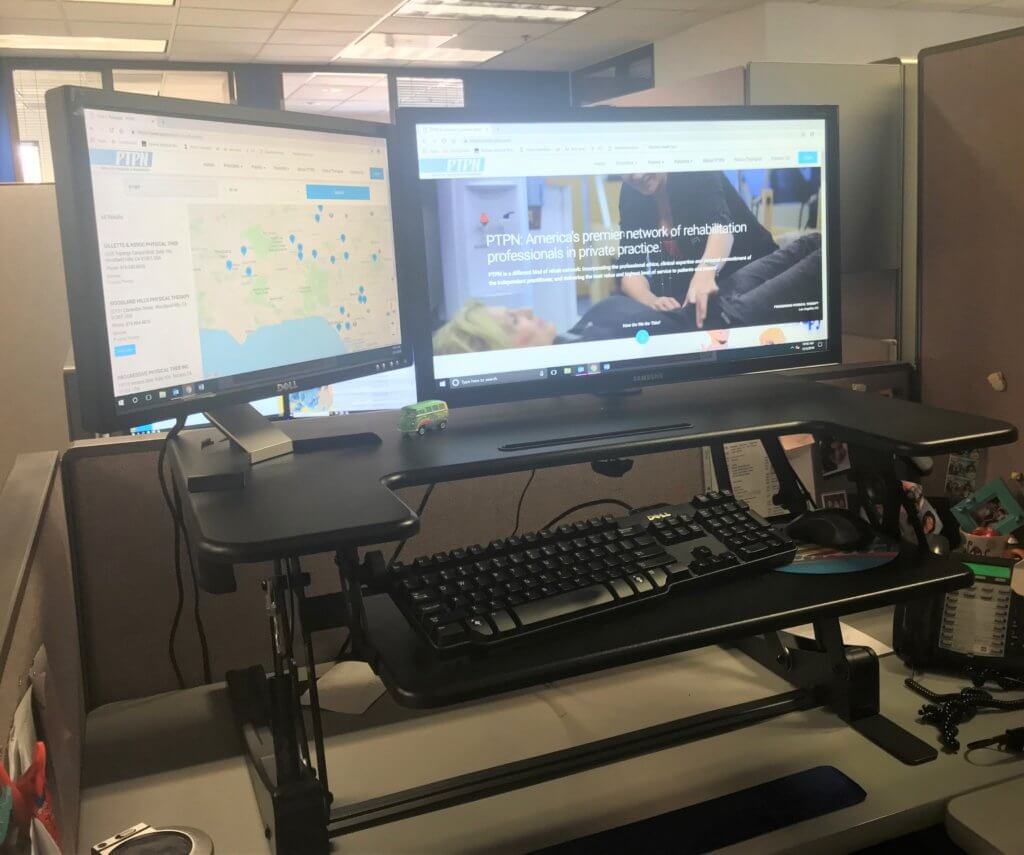We’ve all seen the headlines that emphasize the dangers of sedentary behavior. Yes, Sitting Too Long Can Kill You, Even if You Exercise. Too Much Sitting Is As Bad for the Brain As It Is for the Body. Sitting Is the New Smoking: Ways a Sedentary Lifestyle Is Killing You.
These headlines may grab your attention and scare you, but they don’t convey the wide spectrum of studies you’ll find that may or may not show how sitting too much can lead directly to death. Mike Stare, a physical therapist and a co-owner of Orthopaedics Plus (a Physiquality network member in Massachusetts), has written about this for his clinic’s own website, and he points out that while the studies seem to contradict each other, there are a couple of conclusions to be made when you compare all of the results:
The biggest danger comes from sitting for long periods of time.
If you need to sit for your job, Mike advises trying to sit for less than 11 hours a day, and making an effort to move every 30 minutes or so.
The more you sit, the more your body needs exercise to compensate for that sitting.
While no amount of exercise can completely make up for sitting for long periods of time, Mike points to several studies showing the positive effects of exercise when parts of your day are sedentary. One study suggested that people who are very active can avoid the risks that come with sitting all day:
A meta-analysis consisting of 16 studies of over a million people showed that in those who were highly physically active (60 – 75 minutes of moderate to vigorous activity) were able to eliminate the risk of death associated with prolonged sitting, and attenuate the risk of TV watching. They found that those who were not obese, were not diabetic, and did not sit more than 1 hour a day watching TV had no increased risks of mortality of disease, even if they sat at work for 8 hours per day. (From Mike’s summary of the study: https://orthopaedicsplus.com/2018/09/18/616/)

In addition, says Mike, this same study found that people who were only moderately active had an increased mortality risk. Those who were completely inactive had an even higher risk of disease and death. So clearly there is some relationship between quantity of sedentary time, quality and quantity of exercise, and disease and mortality.
If you’re concerned about the quantity of time you’re sitting at your office, you might consider using a standing desk to add some variety to your posture during the day. Mitch Kaye, a physical therapist and the Director of Quality Assurance for PTPN (the parent company of Physiquality), has worked with staffers at the PTPN headquarters in Calabasas, California, to incorporate standing desks into their workspaces.
Mitch notes that the studies advising standing desks recommend sitting for 30 minutes and standing for 30 minutes each hour. While people who get these desks might commit to such constant change at first, Mitch says, they often end up sitting at their desks as it becomes cumbersome, particularly if you have a desk that requires manual lifting and lowering.

If you’re simply trying to avoid sedentary behavior, Mike recommends skipping the standing desk and adopting these habits during your work day:
- Change your sitting position frequently (every few minutes).
- Get up and move frequently (every 30 minutes).
- Get up at work, standing up for 20 minutes every hour.
- Get up and take a walk every hour or two ideally, but at least take a 15-minute walk for every four hours of work.
That said, there is one group of people who are more likely to benefit from a standing desk — those with back pain. While there can be many causes of back pain, Mike points to a couple of different studies showing that when people with back pain using sit-stand desks, their neck and back pain declines. Mitch has seen this in the PTPN office as well.
The first standing desk installed at PTPN headquarters was for an employee we’ll call Greg, who had back surgery in 2017.
Greg’s surgeon had recommended that he get a standing desk to relieve pressure on his back after his surgery. Greg notes that it did take some time to find the right settings for working at his desk while sitting and while standing. He advises to pay attention to the height of the person using the desk in both sitting and standing situations, and that it is helpful to be able to adjust the height of one’s monitor and keyword between the two settings — what works when one is sitting may be too high, for example, when standing.

Greg’s initial goal was to stand 50% of the time in the vein of the 30 minutes standing, 30 minutes sitting advice many studies have given. A year later, he now stands about 30-35% of the time, depending on what he’s doing and whether his back is hurting. Greg believes that the desk has helped in reducing his back pain by relieving pressure on his back and forcing other muscles in his body to work when he’s standing vs. when he’s sitting.
Ultimately, both Mitch and Mike, as well as Greg, advise doing your research before investing in a standing desk, particularly if you are considering them for your entire office. Make sure your employees are ready to change their habits in order to stand more; it won’t make sense to invest in such a desk if it remains in a permanent sitting position after the first two weeks.
Even more important is to use proper posture, whether you’re sitting or standing, and to try to increase your activity throughout the day. If you’re looking for advice on how to be more active without being distracted from your work, your local Physiquality physical therapist is an excellent resource for starting new healthy habits. Use our therapist finder below to locate the professional nearest you.
Thank you to our contributors:

Mike Stare, PT, DPT, CSCS, CNS, is a physical therapist and co-owner of Orthopaedics Plus, a Physiquality member clinic with two locations outside of Boston, MA. A practicing clinician since 2003, Mike also opened Spectrum Fitness Consulting in 2006 as a way to teach patients and clients about living a healthier life and focusing on prevention of injury, as well as recovery from them.

Mitch Kaye, PT, is the Director of Quality Assurance for PTPN, the parent company of Physiquality. He oversees all aspects of utilization review and case management for the entire PTPN network, and trains and supervises PTPN’s Quality Assurance and Utilization Management staff. Mitch has worked with staffers at the PTPN headquarters in Calabasas, CA, to incorporate standing desks into their workspaces.
Stare, Mike. The truth on stand-up desks. Orthopaedics Plus, September 18, 2018.
Walton, Alice G. Too much sitting is as bad for the brain as it is for the body: Study. Forbes, April 12, 2018.
Physiquality.
- Walk more, be healthier. March 7, 2018.
- How exercise can help prevent disease. June 2, 2014.
Scutti, Susan. Yes, sitting too long can kill you, even if you exercise. CNN, September 12, 2017.
Biswas A, Oh PI, Faulkner GE, Bajaj RR, Silver MA, Mitchell MS, Alter DA. Sedentary time and its association with risk for disease incidence, mortality, and hospitalization in adults: a systematic review and meta-analysis. Annals of Internal Medicine, January 20, 2015.
Sitting is the new smoking: Ways a sedentary lifestyle can kill you. The Huffington Post, September 29, 2014.
Pronk NP, Katz AS, Lowry M, Payfer JR. Reducing occupational sitting time and improving worker health: the Take-a-Stand Project, 2011. Preventing Chronic Disease, October 11, 2012.